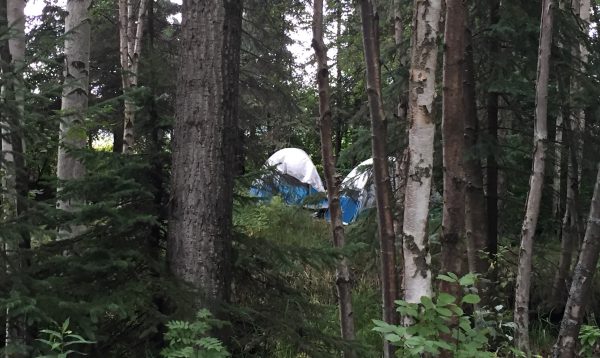
Anchorage’s problem with homeless encampments in public parks and trails is reaching a new “crisis” point. That’s according to a collection of increasingly organized and vocal community groups petitioning the city to get more aggressive in dealing with the problem.
The tension was on full display at an Assembly meeting Wednesday at City Hall, where it was standing room only as advocates, municipal employees and elected officials crowded into a conference room.
Over the last year, meetings of the Assembly’s Homelessness and Public Safety committees have taken on a sense of urgency, with members of the public growing increasingly impatient with the city’s management of the sprawling, unlawful encampments that speckle Anchorage’s parks, trails, and green spaces. Neighborhood groups and community councils have become more organized and involved in the issue, criticizing officials for a lack of transparent communication, and even presenting assembly members with a 12-point list of recommended actions.
Assembly member Dick Traini has served on the body off and on since the early 1991, and says he and his constituents are seeing the issue of homeless encampments on public lands worsen.
“People are more frustrated than ever, because they don’t see anything being done. The camps are not done away with,” Traini said after Wednesday’s committee meeting.
The administration of Mayor Ethan Berkowitz has taken big steps to create new housing and support services to get people off the streets. But it is a long-term strategy that many say has inadequate solutions for addressing ongoing problems like overflowing shelters, a concentration of struggling individuals on the east side of downtown and messy, sometimes dangerous encampments throughout the green-belt that area residents say make them feel unsafe in their own homes.
The city has a system for cleaning up vacated campsites, but it lacks the resources to keep pace with the problem. Parks and Recreation Director John Rodda told the Assembly that since January 1st, crews have cleared 65 tons of material from unlawful encampments — double what they had collected by this time last year.
Right now, the Assembly is re-evaluating its strategy for clearing campsites. It includes a proposal to expedite removal when camps are close to a newly created class of “protected” public areas. That category could include popular trails, playgrounds, schools, as well as recreation areas, and mandate that all campsites within 100 feet be cleared within 72 hours. Currently, individuals have 15 days to leave a site once they are given notice by officials. The move is intended to classify broad zones where encampments cannot take root.
The proposal could spark a legal challenge from civil rights groups. Traini doesn’t think the potential for litigation should stop the Assembly from taking more assertive measures.
“My constituents are calling me up, demanding action (be) taken. And they’re right,” Traini said. “We’re the ones elected to do this.”
In addition to the Assembly’s revised abatement ordinance, the administration is set to unveil new components of its strategic action plan on homelessness in July.
Zachariah Hughes reports on city & state politics, arts & culture, drugs, and military affairs in Anchorage and South Central Alaska.
@ZachHughesAK About Zachariah




